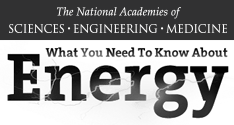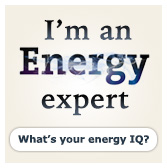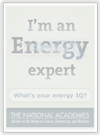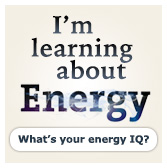
What You Need To Know About Energy
What do you know about energy?
The United States is home to how many of the world's automobiles?
-
Sorry, that’s incorrect.
With less than 5% of the world's population, the United States is home to one-third of the world's automobiles.
-
Correct!
With less than 5% of the world's population, the United States is home to one-third of the world's automobiles.
-
Sorry, that’s incorrect.
With less than 5% of the world's population, the United States is home to one-third of the world's automobiles.
True or false? Carbon capture and storage would reduce energy efficiency of a coal plant?
-
Correct!
Carbon capture and storage will reduce energy efficiency of a coal plant, though it will decrease carbon emissions.
-
Sorry, that’s incorrect.
Carbon capture and storage will reduce energy efficiency of a coal plant, though it will decrease carbon emissions.
Between 1980 and 2012, after fuel economy standards where put in place, which of the following has happened to vehicles?
- Vehicle weight increased
- Vehicle horsepower increased
- Vehicle fuel economy increased
- All of the above
-
Sorry, that’s incorrect.
Improved vehicle efficiency has allowed for increases in weight, horsepower and fuel economy.
-
Sorry, that’s incorrect.
Improved vehicle efficiency has allowed for increases in weight, horsepower and fuel economy.
-
Sorry, that’s incorrect.
Improved vehicle efficiency has allowed for increases in weight, horsepower and fuel economy.
-
Correct!
Improved vehicle efficiency has allowed for increases in weight, horsepower and fuel economy.
How many gallons of water are required to hydraulically fracture a well, on average in the U.S.?
-
Sorry, that’s incorrect.
The national average is around 1.5 million gallons per well , according to the EPA.
-
Sorry, that’s incorrect.
The national average is around 1.5 million gallons per well , according to the EPA.
-
Sorry, that’s incorrect.
The national average is around 1.5 million gallons per well , according to the EPA.
-
Correct!
The national average is around 1.5 million gallons per well , according to the EPA.
On average, how much solar radiation reaches each square meter of earth?
-
Sorry, that’s incorrect.
On average, even after passing through hundreds of kilometers of air on a clear day, solar radiation reaches Earth with enough energy in a single square meter to run a mid-size desktop computer-if all the sunlight could be captured and converted to electricity.
-
Correct!
On average, even after passing through hundreds of kilometers of air on a clear day, solar radiation reaches Earth with enough energy in a single square meter to run a mid-size desktop computer-if all the sunlight could be captured and converted to electricity.
-
Sorry, that’s incorrect.
On average, even after passing through hundreds of kilometers of air on a clear day, solar radiation reaches Earth with enough energy in a single square meter to run a mid-size desktop computer-if all the sunlight could be captured and converted to electricity.
True or False: Burning biofuels does not release carbon dioxide.
-
Sorry, that’s incorrect.
Biofuels contain carbon and although they may burn “cleaner” than oil-derived fuels, they do not avoid generating carbon dioxide emissions.
-
Correct!
Biofuels contain carbon and although they may burn “cleaner” than oil-derived fuels, they do not avoid generating carbon dioxide emissions.
Which source(s) of energy are not nuclear in origin?
-
Sorry, that’s incorrect.
Tidal energy is gravitational in origin. Solar energy comes from nuclear reactions in the sun.
-
Sorry, that’s incorrect.
Tidal energy is gravitational in origin. Geothermal energy comes from radioactive decay inside the earth.
-
Correct!
Tidal energy is gravitational in origin. Solar energy comes from nuclear reactions in the sun, and geothermal energy comes from radioactive decay inside the earth.
-
Sorry, that’s incorrect.
Tidal energy is gravitational in origin. Solar energy comes from nuclear reactions in the sun, and geothermal energy comes from radioactive decay inside the earth.
Which of the following sources do experts expect will provide us with the “silver bullet” solution to our energy needs?
-
Sorry, that’s incorrect.
There is no silver bullet. Tomorrow’s energy, like today’s, will come from a variety of sources.
-
Sorry, that’s incorrect.
There is no silver bullet. Tomorrow’s energy, like today’s, will come from a variety of sources.
-
Sorry, that’s incorrect.
There is no silver bullet. Tomorrow’s energy, like today’s, will come from a variety of sources.
-
Correct!
There is no silver bullet. Tomorrow’s energy, like today’s, will come from a variety of sources.
If electricity production wastes between 40 and 65% of the primary energy source, why is it used?
- Producing electricity is a way to store energy.
- Electricity production results in no harmful emissions.
- Electricity is a versatile energy carrier.
-
Sorry, that’s incorrect.
Most direct uses of primary energy are limited to generating heat and motion. Electricity, by contrast, is extremely versatile, with a wide range of complex applications.
-
Sorry, that’s incorrect.
Most direct uses of primary energy are limited to generating heat and motion. Electricity, by contrast, is extremely versatile, with a wide range of complex applications.
-
Correct!
Most direct uses of primary energy are limited to generating heat and motion. Electricity, by contrast, is extremely versatile, with a wide range of complex applications.
Thank you for taking our quiz.
Place this badge on your facebook page to show your friends what you know about energy.
Place this badge on your facebook page to show your friends what you know about energy.
Place this badge on your facebook page to show your friends what you know about energy.
Explore Other Topics
Energy Hands-on
Understanding Efficiency
Learn the significance of energy efficiencyThe Promise of Better Lighting
Energy savings through lighting technologyOur Energy System
A visualization of all our energy sourcesEnergy Defined
- Photovoltaic (PV) Cell
Sometimes referred to as a solar cell, a device that utilizes the photoelectric effect to convert incident sunlight directly into electricity. This can be distinguished from solar thermal energy, which is sometimes used to create electricity indirectly.




